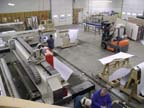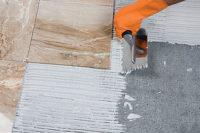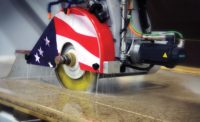
Choosing the proper building can be a very trying chore, but it is extremely important for the smooth operation and growth of your business. In looking at a building, imagine it in full production. Where will your saw be placed? Where will you store your finished product? A stone fabrication facility should flow like an assembly line.
Building Requirements
Building Size
The size of the building is important. Too small a building and you will quickly outgrow it. A small workspace will also hamper production and may be considered unsafe if workers are constituently tripping over one another. We recommend that you choose a building that is a minimum of 5,000 square feet. At least 3,000 to 4,000 of this should be shop space, and the remaining can be used as office space. This is important for several reasons. First, many startup shops will grow rapidly after the first year in business. If you don't plan for this growth, you will quickly outgrow the building. If you have leased a building, and you are tied into a three- or five-year lease, then you are stuck for the remainder of the lease. If you own the building and have not planned for expansion, then you will also suffer.
In addition to the square footage, you should also pay attention to the elevation of the building. In other words, the building should be on ground level and not elevated above ground. This is also critical when considering the weight of stone slabs, which can be difficult to move into a building. A building with a loading dock is fine, as long as you have ground level access to the shop. We prefer you have a building with a concrete slab that can support heavy loads.
Building Location
Unlike many retail operations, the building's location is not critical for the stone fabricator. This is especially true if you are in an area without a lot of competition. Walk-in or drive-by traffic is not a major concern. We prefer you are located in an industrial park or similar area where trucks can easily move in and out. You will be receiving stone slabs, which are delivered on large flatbed trucks. If these trucks cannot gain access to your shop or are restricted in your area, then this is a major problem. When looking for a building, drive around the area and make sure that there are no truck weight limit restrictions. If there are restrictions, then you must look somewhere else.
Parking Area and Yard
Just as important as the building is the parking lot and land surrounding it. You should have an area that is paved. Gravel and dirt are not acceptable since it will make driving a forklift difficult and dangerous when moving slabs. If you plan on storing your slabs outside, then you need plenty of room for storage. Make sure you also have plenty of room to move slabs around. We recommend that you have at least an area that is 100 x 100 feet. The more room you have, the better off you are. If you are leasing the building, make sure the landlord is aware that you will be storing slabs outdoors. This can cause major problems if they will not let you store anything outside. Of course, if you plan on storing all your slabs inside, you will need a much larger building than what has been recommended above.
Make sure that there is plenty of room for the truck to turn around as well as room to unload the slabs. Make sure there are no power lines in the way, so that when the truck unloads the slabs there is no danger of hitting the power lines. This could be a potentially deadly situation.
Building Interior
The building should have at least 12-foot-high ceilings. You are going to have to lift the slabs up onto your saw table, and any ceiling height lower than 12 feet will make it difficult to move.
You will also need to check the slope of the interior shop floor. Take some small marbles and place them on the floor to see which way the floor slopes. This is important since you will be using lots of water. The water needs to be able to run in a location where it can be easily collected and recycled or disposed of. While slope is important, it is not critical to building selection. Drains and/or dams can be constructed to help move the water to its desired location. If this is the case, you need to make sure it is cleared with the landlord.
Water Volume
The building should have adequate water volume. Your saw will be using water at a rate of about 5 gallons a minute. Check to make sure there is enough water volume to the building.
Building Entrances
A very important feature to look for in your building is the size of the overhead doors. The doors should be at least 12 feet high. If the doors are smaller than 12 feet, then it will be extremely labor intensive trying to move full slabs in and out of the building. This can be a very time-consuming chore and will eat into your productivity. If you are building your own facility, I would plan on 16-foot-high overhead doors.
Building Power Requirements
The building must have three-phase power with an electrical service of at least 200 amps. This is very important since most of the large equipment - including your saw, router, air compressor and other equipment - all work on three-phase power. If the landlord is not sure whether there is three-phase power, have an electrician check it out before you sign a lease. I have had realtors and landlords tell someone that a building has three-phase power, and it did not. I would make sure that this is put in the lease. If the building does not have three-phase power, then you may need to have the power company run it to the building. This can be very expensive. If the building does not have existing three-phase power, I would look somewhere else. Don't even consider not having three-phase power. There is equipment that will run on single-phase, but it is underpowered and you will easily burn out with the rigors of stone fabrication.
Pre-Opening Requirements
Setting up Shop
Once you have your building, it is now time to set up your shop. The set-up of your shop is important, and you need to coordinate all the trades so that you can open and be operational on time. The following is a step-by-step guide to setting up your shop.
Building Lease
The first step is to have the lease signed and to have access to the building. Make sure that your attorney has carefully reviewed the lease. Make sure any work that needs to be done to set up the shop - digging drains, storing slabs, running power and water, etc. - are all approved by the landlord and in the lease.
Business License
You will need to contact the city or county that your business is in and obtain an occupational license. In addition, some other states, cites and counties may require other licenses and permits. Check with local authorities to find out if any are required.
Order Saw and Air Compressor
If you are intending on buying a large bridge saw, it should be ordered as soon as you have located a building. The saw can take up to six weeks to arrive and another several days to have it set up and running. If you are starting with a small rail or track type saw, this time frame is not that critical.
Depending on the bridge saw model and manufacturer, you also may be required to provide certain installation tools, such as a hammer drill and other special tools. If your saw has a concrete bed, you will also need to purchase the concrete, build forms and rent a large cement mixer. All these requirements should be noted by the saw manufacturer in advance.
If you are going to go with air tools, you will need a good air compressor. Some of the larger compressors can take just as long to order as a saw. Line up the compressor, and make sure to order it in plenty of time for opening day.
Utilities
You will need to have all your utility deposits in place and your utilities turned on. This includes your power, water, gas, telephone, etc. This can take some time, so make sure you do this the minute you have a signed lease.
You will need to hire a licensed electrician to run all the power you will need for your equipment. Before you can instruct the electrician, you need to have your shop laid out on paper. Again, it is critical that the shop has three-phase power. You may be starting off small, but you will grow. When you are ready to move up to a larger saw, CNC, waterjet or other equipment, you will need three-phase power. If your shop does not have it, it can be very expensive to set up. You can always use phase convertors, but the reliability of a phase converter for everyday use is questionable.
Electrical
The following is the minimum requirements you will need to set up your electrical power:
• Two cut off switches; amps for the main saw
• Two three-phase 220 outlets near where you will be using the router
• Several 110-v outlets for use of small saws and other hand-held power tools
Air Requirements
It is our experience that using air is far more economical and more efficient than electric tools. The air compressor you choose should have a minimum 100 CFM. This compressor will require a location outside or indoors. The reason for locating the compressor outdoors is to reduce the noise level. If outdoors, a separate shed should be built around it to protect it from the elements. If located indoors, it should be placed in a location as far from the work area as possible. An indoor shed may also be constructed if this is not possible. The air compressor will need to be ordered four weeks before it is needed. The compressor will also require three-phase power.
In addition to the air compressor, you will also need to run air lines and have air reels. NTC recommends that you start with a minimum of three reels for air and three reels for water. Retractor able reels can be purchased at Home Depot, Lowes or any other tool supply company. You will need at least a 25-foot reel with hose depending on your building height. Your lines should be run with a minimum of 1-inch-diameter copper piping. The amount of piping you will need depends on your building and shop layout.
Many start up shops make the mistake of buying an air compressor that is used for automotive work. You know those large-tank air compressors you see at Sams Club, Costco or other retailers? While they may look big and appear that they should be enough air to run your tools, this is not the case. Most of those compressors sold at these places are for common air tools. The air tools we use in the stone industry require much more CFM. For example, a typical air tool for polishing may require as much as 18 CFM. The automotive air compressors will at best put out 12 CFM. You need to buy a good compressor. Here is how you can calculate the size compressor you will need:
Add up all the CFM required for all the air tools you will be using at one time. For example, if you have three air polishers at 18 CFM per polisher, that's a total of 54 CFM required. Now add an additional 20%. In our example, that would be another 11 to 12 CFM. This means you will need at minimum a 70-CFM air compressor, and that does not include room for growth.
There are basically two types of compressors. A piston compressor and a continuous screw compressor. If you can afford it, I would recommend going with the screw compressor. A screw compressor produces a constant air supply without the need for a storage tank. A piston compressor works by storing air in a reserve tank.
Miscellaneous
You will need to order two dumpsters. One will be used for stone scrap. Make sure to tell the refuse company that you will be throwing stone away and that it will be heavy. Arrange to have it picked up on a weekly basis. The second dumpster will be needed for everyday trash.
Office Set Up
Your office should be set up as soon as you have power. The following is the bare minimum you will need for the office:
• Phones - I would recommend at least two lines. This way, customers will not have to wait or hear a busy signal. I would also ask the phone company for a voice mail box. Answering machines are unreliable, and they will not work if the power goes off. A voice mail system will still take messages when the power is off, and it makes your company more professional.
• Fax machine - Many of your quotes will be faxed to you, so a fax machine is important. However, a fax machine can tie up one of your phone lines, and this can be a problem. You may want to consider an e-mail fax system. This is an inexpensive service that allows the fax to go directly to your e-mail address.
• Internet connection-DSL or Cable - In addition to being able to receive your e-fax as I mentioned above, having a high-speed internet connection will allow you to look at stone samples from the many distributors that have useful Web pages.
• Desks, file cabinets, etc. - Rather than a standard desk, why not take some of your scrap slabs and make your own desk? You are a stone fabricator; why not show your customers what else you can do? Plus, you might end up selling one.





